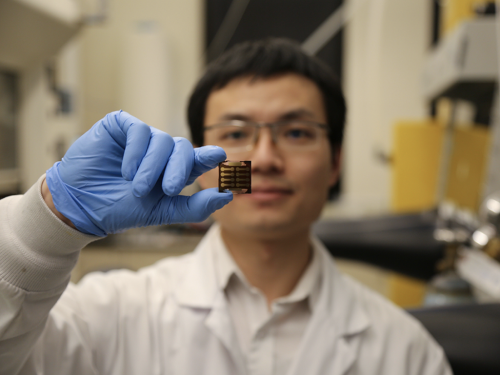Solar cell development has been a hot topic in recent years. First created in the 1950s, solar cell technologies are now continuously updated to have both improved performance and an easier manufacturing process. Solar cell production is currently expensive and very difficult, requiring temperatures above 500 degrees Celsius. Recently published in Science in February 2017, researchers at the University of Toronto made significant advances in alternative solar cell technology, bringing its production to lower temperatures and making it compatible with conventional silicon cells—potentially leading to the commercial-scale manufacturing of solar cells that are more efficient.
Most solar cells use crystalline silicon as a light-harvesting material. These solar cells already have an efficiency—the amount of input energy from sunlight that can be converted to electricity—of above 26 percent, said Zhenyu Yang, postdoctoral fellow at the University of Toronto and a co-author on the study. “One drawback in existing crystalline silicon solar cells is that manufacturing is complex and requires high processing temperatures,” explained Hairen Tan, postdoctoral researcher at the University of Toronto and the lead author on the study.
Engineers have recently begun to use metal-halide perovskite—a class of perovskite-structured crystal composed of earth-abundant elements such as lead and iodine—as a new high-efficiency solar cell material. Perovskite cells can be made thinner and more flexible, allow a lower temperature to manufacture, and can potentially be combined with a more rigid silicon cell to harvest more energy. “Among all-solution-processed solar cells, perovskite-based solar cells show great potential as the new generation photovoltaics,” Yang said. However, perovskite is known to be less stable than its inorganic counterparts. Oleksandr Voznyy, research associate at the University of Toronto and co-author on the study, said that current research focuses on how to make the material stable for a long time under operation conditions.
The University of Toronto researchers found a way to bypass some of the problems of the perovskite solar cells (PSC): they developed a process that is low-temperature compatible, able to be run below 200 degrees Celsius. Voznyy added that the process also allows the electron-extracting layer of the solar cell to be grown on a flexible polymer substrate. Flexible substrates, including plastic films and curved surfaces, cannot withstand high temperatures because they would simply melt under the heat, and thus couldn’t be used in previous manufacturing of solar cells.
“The biggest implications of our research are that a low-temperature process of producing the solar cells is now compatible with flexible substrates and that it can be deposited on top of silicon solar cells to harvest more energy without damaging them,” said Tan. “Flexible substrates allow you to print the solar cell like a newspaper, which wasn’t possible with previous materials and processes.”
The high performance of perovskite has been demonstrated in the past. For example, Stanford researchers developed a perovskite solar cell last October with an efficiency of 20 percent, comparable to current silicon solar cells on the market today. However, scientists are now working to make them commercially available, which means they have to be more stable. To achieve this, the researchers improved the electron selective layer. They added chlorine atoms in between the perovskite and the titanium, which serve as an effective link that can bind both materials. This change to the interface of the two layers reduces positively-charged electron vacancies in the cell layer, thus improving the stability of the whole solar cell.
“These devices [made with our PSC] will be low-cost, highly stable, efficient, and solution-processible and could be could be further integrated to many types of surfaces—such as building roofs, walls, windows, and roads—to harvest light,” Yang said. This PSC technology can be used to create low-cost, printable solar panels for solar windows that reduce energy use, as well as for smartphone covers with charging capabilities. With high thermal and atmospheric stability, rooftop solar panels, for example, could last decades, rather than degrading quickly when exposed to moisture or light.
The researchers are continuing their investigation into this new PSC technology. Tan explained that they are now working with other labs to develop devices with both crystalline silicon cells and their new perovskite technology to further improve cell stability and power conversion efficacy.

